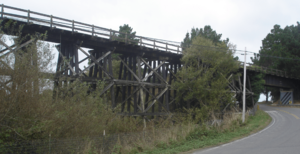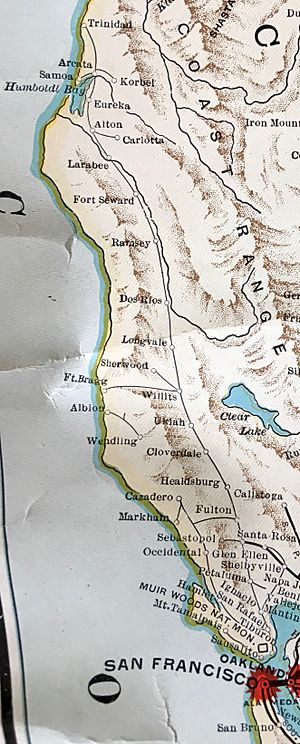Northwestern Pacific Railroad facts for kids
Quick facts for kids Northwestern Pacific Railroad |
|
|---|---|
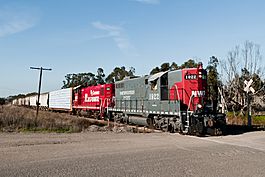
NWP #1922 running freight near Petaluma, California; October 21, 2011
|
|
| Overview | |
| Status | Operational (partial) |
| Owner | Sonoma-Marin Area Rail Transit |
| Termini | Schellville Samoa |
| Website | |
| Service | |
| System | NWP |
| Operator(s) | NWPco Sonoma–Marin Area Rail Transit |
| Depot(s) | Freight: Schellville Passenger: Mark West |
| History | |
| Opened | 1907 |
| c. 1980 | closed to all traffic |
| 1989 | North Coast Rail Authority established |
| 2011 | Service begins under NWPRA |
| Technical | |
| Line length | 271 mi (436 km) 62 mi (100 km) (operational) |
| Character | freight and commuter railroad |
| Track gauge | 1,435 mm (4 ft 8 1⁄2 in) standard gauge |
The Northwestern Pacific Railroad (reporting mark NWP) is a railway in California. It currently runs for about 62 mi (100 km) between Schellville and Windsor. This part of the line carries both freight (cargo) trains and Sonoma–Marin Area Rail Transit (SMART) commuter trains.
In the past, the NWP was a much longer railway. It stretched 271 miles (436 km) from Schellville all the way to Eureka. It also had a smaller section near San Rafael. This railway was mostly used to transport lumber (wood) from the forests of the North Coast of California.
Today, the part of the NWP line between Larkspur in Marin County and Healdsburg is owned by SMART. The other sections, from Schellville to Ignacio and from Healdsburg to Eureka, are owned by the North Coast Railroad Authority (NCRA). A private company, NWPco, runs freight services on the NCRA-owned parts.
A new plan called the Great Redwood Trail Act (from 2018) aims to turn the abandoned railway path from Eureka to the San Francisco Bay into a walking and biking trail.
Contents
History of the Railroad
In the late 1800s, two big railway companies, the Southern Pacific Railroad (SP) and the Atchison, Topeka and Santa Fe Railway (AT&SF), wanted to build lines north from San Francisco. Their goal was to bring lumber from Humboldt County down south.
The Southern Pacific controlled the southern part of the line, and AT&SF controlled the northern part. Both planned to build more tracks to connect their sections. But they soon realized that only one railway would be successful in serving Mendocino and Humboldt Counties. So, in 1906, SP and AT&SF decided to work together. They combined 42 smaller railway companies to create one long line stretching from Sausalito to Eureka.
The big 1906 San Francisco earthquake caused problems for the project. Many plans and documents were destroyed. But construction continued, and the railway was finally finished in October 1914. A "golden spike" ceremony was held to celebrate this big achievement.
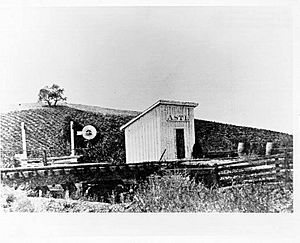
At first, the railroad used ferries of San Francisco Bay to move freight across the water. Later, in 1888, it connected to the national railway network at Napa Junction. This made it easier to move goods.
The railway became very popular. Early schedules show many passenger trains and dozens of freight trains running every day. The trains quickly replaced steamships as the main way to get lumber from Humboldt County to markets. This rail service also helped the lumber industry grow in inland areas.
In 1929, AT&SF sold its share of the NWP to the Southern Pacific. This made the NWP a full part of the Southern Pacific company.
The Southern Pacific Era
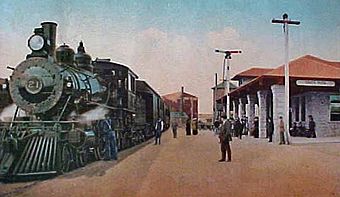
Train at Santa Rosa, California in 1911
|
|
| Overview | |
|---|---|
| Headquarters | Schellville, California - Operational Palo Alto, California - Administrative |
| Reporting mark | NWP |
| Locale | California's North Coast from Marin County to Eureka |
| Dates of operation | 1907–1998 |
| Successor | Southern Pacific Transportation Company Eureka Southern Railroad |
| Technical | |
| Track gauge | 4 ft 8 1⁄2 in (1,435 mm) standard gauge |
| Previous gauge | 80 miles (130 km) of system originally 3 ft (914 mm) |
| Length | 271 miles (436 km) |
| Other | |
| Website | |
| Year | Traffic |
|---|---|
| 1925 | 150 |
| 1944 | 348 |
| 1960 | 604 |
| 1970 | 421 |
Passenger train service was very busy until the 1930s. At that time, better roads and highways made it easier and cheaper to travel and ship goods by car and truck. By 1935, both freight and passenger services decreased because of the Great Depression.
During World War II, freight shipments increased, but passenger service stayed about the same. In the 1950s, freight service on the NWP grew even more. This was because of a high demand for lumber due to the post-war housing boom.
Many smaller branch lines were taken apart during the 1930s. By 1953, diesel engines were used for almost all trains. On November 10, 1958, all main passenger service south of Willits stopped. The last remaining passenger service, a train between Willits and Eureka, ran until April 30, 1971. When Amtrak took over intercity passenger rail service in 1971, they did not continue service on the NWP.
The 1964 Flood Damage
A terrible flood in December 1964 destroyed about 100 miles (160 km) of the railroad in Northern California. Three bridges over the Eel River were ruined, and the land itself changed. The line was closed for 177 days while 850 workers rebuilt the railway through the Eel River canyon. It reopened on June 16, 1965.
After the 1964 flood, the railway line became less reliable. There were more landslides in the Eel River Canyon. However, freight traffic stayed high until the 1970s. This changed when improvements to US Highway 101 made trucking faster and more competitive with the railway.
The 1978 Tunnel Fire
Many lumber mills in Humboldt County started shipping their wood by truck after a fire in September 1978. This fire caused the Island Mountain tunnel (tunnel 27) to collapse. The line north of Willits was closed. When it reopened in December 1979, only half of the previous lumber traffic returned to the rails.
The money earned from the remaining traffic was not enough to maintain the tracks through the Eel River Canyon. This part of the line was the most expensive to keep up in the United States. In September 1983, the Southern Pacific announced it was closing the NWP line north of Willits. This led to a legal fight, and a court ordered the line to reopen in March 1984.
Changes and New Owners
In 1984, the Southern Pacific sold the northern part of the line (from Willits to Eureka) to Bryan Whipple. He ran it as the Eureka Southern Railroad. This company operated freight trains and tourist trains. But it went bankrupt because of storm damage in the Eel River Canyon.
North Coast Railroad Authority
The California government created the NCRA in 1989 to prevent the NWP from being completely abandoned. The NCRA bought the Eureka Southern in 1992. They then leased the line to a new company called the North Coast Railroad. This company operated until late 1996.
Severe flooding of the Eel River caused widespread damage and destroyed parts of the railway. This damage was not repaired for many years. In 1998, the Federal Railroad Administration (FRA) stopped all train operations north of Willits. This order was later changed to allow the California Western Railroad to operate to Willits Depot.
The Golden Gate Bridge, Highway and Transportation District started buying parts of the NWP's southern end from the Southern Pacific. The Southern Pacific also began to lease the line to the California Northern Railroad (CFNR).
The New NWP (2009–Present)
In 2009, the new SMART (Sonoma-Marin Area Rail Transit) began electrical work on the line from Schellville to Windsor. They also replaced old ties and added new gravel (ballast) to the tracks.
The Northwestern Pacific Railroad officially reopened the line and began operations in June 2011. This was on the section of track between Napa and Windsor, California. In July 2011, the first freight train delivered grain to Petaluma.
Today, trains on the NWP run from the Lombard connection with the California Northern Railroad up to Windsor. There are usually about three trips per week. The railroad carries grain for dairy and poultry farms in Sonoma County. It also transports lumber products from Windsor and Schellville.
Regular passenger trains began in late spring 2017 between Sonoma County Airport and San Rafael. There are bus connections to the Larkspur ferry and the city of Cloverdale. SMART plans to extend commuter service to Cloverdale in the future. The NCRA and NWPco also hope to open the line to the Skunk Train connection in Willits. However, there is no set timeline for this.
Because of financial problems and legal issues, the North Coast Rail Authority has lost favor with state officials and the public. Many people now want to replace the old railway line with walking and biking trails. California's 2018 Great Redwood Trail Act includes plans to deal with the Authority's debts, close down the NCRA, and turn its railway paths into trails.
In September 2020, Sonoma–Marin Area Rail Transit bought 21 miles (34 km) of the line from Healdsburg north to the Mendocino-Sonoma County border. In February 2021, they took over freight operations.
Main Route of the Railroad
The NWP uses mileposts that show the distance from San Francisco. Here are some key points along the route:
- Milepost 40.4 – Schellville
- Milepost 28.7 – Black Point bridge over Petaluma River
- Milepost 25.8 – Ignacio junction
- Milepost 27.8 – Novato
- Milepost 37.2 – Haystack bridge over Petaluma River
- Milepost 38.5 – Petaluma
- Milepost 46.1 – Cotati
- Milepost 53.8 – Santa Rosa
- Milepost 58.5 – Fulton
- Milepost 62.9 – Windsor (This is currently the northernmost point where trains operate on the NWP.)
- Milepost 67.6 – bridge over Russian River
- Milepost 68 – Healdsburg
- Milepost 75.8 – Geyserville
- Milepost 85.2 – Cloverdale
- Milepost 100.1 – Hopland
- Milepost 114 – Ukiah
- Milepost 120 – Calpella
- Milepost 122.1 – Redwood Valley
- Milepost 131.4 – Ridge summit (the highest point on the line)
- Milepost 139.5 – Willits (This is where the California Western Railroad (Skunk Train) connects. A reconnection is planned.)
- Milepost 166.5 – line enters Eel River Canyon at Dos Rios
- Milpost 194.8 – bridge over Eel River at the south entrance of Island Mountain tunnel
- Milepost 206.5 – bridge over Eel River
- Milepost 209 – Alderpoint
- Milepost 237.7 – South Fork bridge over Eel River
- Milepost 255.6 – Scotia
- Milepost 261.8 – bridge over Van Duzen River
- Milepost 262.7 – Alton junction
- Milepost 266.1 – Fortuna
- Milepost 271 – Loleta
- Milepost 284.1 – Eureka
- Milepost 292.5 – Arcata
- Milepost 295.2 – Korblex
- Milepost 300.5 – Samoa
The Narrow-Gauge Line
The NWP also had a 3 ft (914 mm) narrow-gauge line. This line was built in 1873 as the North Pacific Coast Railroad. It started with a San Francisco ferry connection at Sausalito and went to the Russian River at Monte Rio. Over time, the tracks were extended to Duncans Mills and Cazadero.
This narrow-gauge line became the "Shore Division" of the NWP in 1907. It was very important for carrying redwood lumber to rebuild San Francisco after the 1906 San Francisco earthquake. Ferries like Lagunitas and Ukiah carried the narrow-gauge freight cars across San Francisco Bay.
After a flood in 1907, the NWP rebuilt a bridge and made part of the line "dual-gauge." This meant it had tracks for both narrow and standard gauge trains. This allowed redwood lumber to be shipped out more easily.
Summer tourists from San Francisco used to visit Russian River vacation spots using the narrow-gauge line. But by 1927, car travel became more popular. The southern part of the line was changed to standard gauge by 1920. Lumber production in the lower Russian River valley ended after a wildfire in 1923. The last narrow-gauge train ran on March 29, 1930. The remaining narrow-gauge line was taken apart that autumn.
Narrow-Gauge Route
Mileposts for the narrow-gauge line also show the distance from San Francisco.
- Milepost 6.5 – Sausalito
- Milepost 11.7 – tunnel 1
- Milepost 12.6 – Corte Madera
- Milepost 13.4 – Larkspur
- Milepost 14.7 – Kentfield
- Milepost 16.5 – San Anselmo
- Milepost 18.3 – Fairfax
- Milepost 20.7 – tunnel 2
- Milepost 23.1 – Nicasio
- Milepost 27 – bridge over Paper Mill Creek
- Milepost 35.6 – Arroyo San Geronimo trestle
- Milepost 36.4 – Point Reyes Station
- Milepost 45.4 – Marshall
- Milepost 50.5 – bridge over Keyes Creek
- Milepost 51.9 – tunnel 3
- Milepost 53.1 – Tomales
- Milepost 53.7 – tunnel 4
- Milepost 54.9 – Stemple Creek trestle
- Milepost 58.8 – Estero Americano Creek trestle
- Milepost 59.5 – Valley Ford
- Milepost 61.9 – Ebabias Creek trestle
- Milepost 62.2 – Bodega Road crossing
- Milepost 62.7 – Salmon Creek trestle
- Milepost 63.7 – Freestone
- Milepost 65.2 – Salmon Creek trestle
- Milepost 66.9 – Brown Creek trestle (This was a very high trestle when it was built in 1876.)
- Milepost 67.6 – Occidental
- Milepost 68.7 – Maquire Creek trestle
- Milepost 69.0 – Camp Meeker
- Milepost 70.5 – Larry Creek trestle
- Milepost 70.8 – bridge over Dutch Bill Creek
- Milepost 71 – tunnel 5
- Milepost 71.6 – bridge over Dutch Bill Creek
- Milepost 71.7 – bridge over highway
- Milepost 73.8 – Monte Rio
- Milepost 77 – bridge over Russian River
- Milepost 77.1 – Duncans Mills
- Milepost 82.1 – bridge over Austin Creek
- Milepost 84.3 – Cazadero
The Railroad in Movies
The Northwestern Pacific Railroad has appeared in several movies and films. This is because of its interesting history and the beautiful natural scenery along its route.
One famous movie is Alfred Hitchcock's Shadow of a Doubt. It was filmed in downtown Santa Rosa, California in 1942. The movie used the old stone train station and railway yard as a background. It also included footage shot from an NWP passenger train.
The NWP trestle (a type of bridge) at Greenbrae, Marin County, was shown in the 1971 film Dirty Harry. In the movie, Clint Eastwood's character famously jumped from the trestle onto a school bus.
A TV show called "Moonlighting" used footage of a Eureka Southern "North Coast Daylight" train in a 1985 episode. The episode was about a murder mystery dinner train.
In 1991, a TV remake of Shadow of a Doubt was filmed at the Petaluma NWP station. It used old passenger train cars and a Southern Pacific locomotive.
The 2003 film Cheaper by the Dozen also used the Santa Rosa Railroad Square and station area as a backdrop.
The film Bloodloss (also known as Day of Vengeance) used the tracks south of Dos Rios for filming in 2008.
Images for kids


